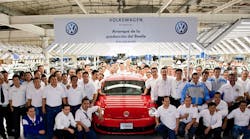As the auto sector in Mexico has grown, post NAFTA, from 15.8% of GDP in 2001 to 20. 3% in 2011, the type of work has changed as well.
“The central region automotive cluster has grown to include higher value activities like engineering and design – moving beyond low-skill parts manufacturing to generation of increased prosperity for the region,” according to a report by the Harvard Business School ( Spring 2013) on the automotive cluster in Central Mexico.
“As a result, the Central Region concentrates most of the engineering and design centers for auto companies, which go beyond manufacturing to provide the highest value added activities in the automotive cluster in Mexico,” the report states.
This has occurred despite the fact that the “the country is below advanced country standards in productivity, education, and innovation, among other measures, the central region offers signs of strength,” explain the authors of the report.
The region, which includes Mexico City, State of Mexico, Puebla, Hidalgo, Morelos and Tlaxcala, is home to more than 30 million (25% of the total population in Mexico).
In terms of its economic capacity, combined, the three states have an aggregate GDP of $360 billion accounting for 30% of Mexico’s GDP.
In addition to economic strenght the region has a strong workforce. This is an important factor that has led OEMs to add high value production in this part of the world. The area has the highest concentration of higher education institutions, which include universities and echnical colleges. Likewise, they have the highest number of students with bachelor degrees.
And the states are capitalizing on this advantage. For example in Guanajuato the state helps find candidates for companies and, in some cases, gives them free classes to help them pass standardized tests required for employment.
A talented workforce is also better able to contribute to innovation such as new products. When Volkswagen (IW 1000/7) expanded in Puebla in 2010 the company cited “efficient production with high localization and new products tailored to the wishes of our North American customers,” that will cause further growth in Central Mexico. With an annual production capacity of 525,000 units, Puebla is now one of the largest car manufacturing plants in the Volkswagen Group.
In Puebla, manufacturing accounts for 25% of GDP, of which automotive production accounts for more than 60% of the total manufacturing sector.
And more growth is predicted. “Based on our analysis, the auto industry could double in size by 2015, to $78 billion worth of goods and services,” said AT Kearny in its report “Reigniting Mexico’s Automotive Industry.” If these trends continue, Mexico could see nearly twice the number of automotive jobs by 2030 (from the current 470,000 to more than 800,000) and greater prosperity for the economy overall.”



